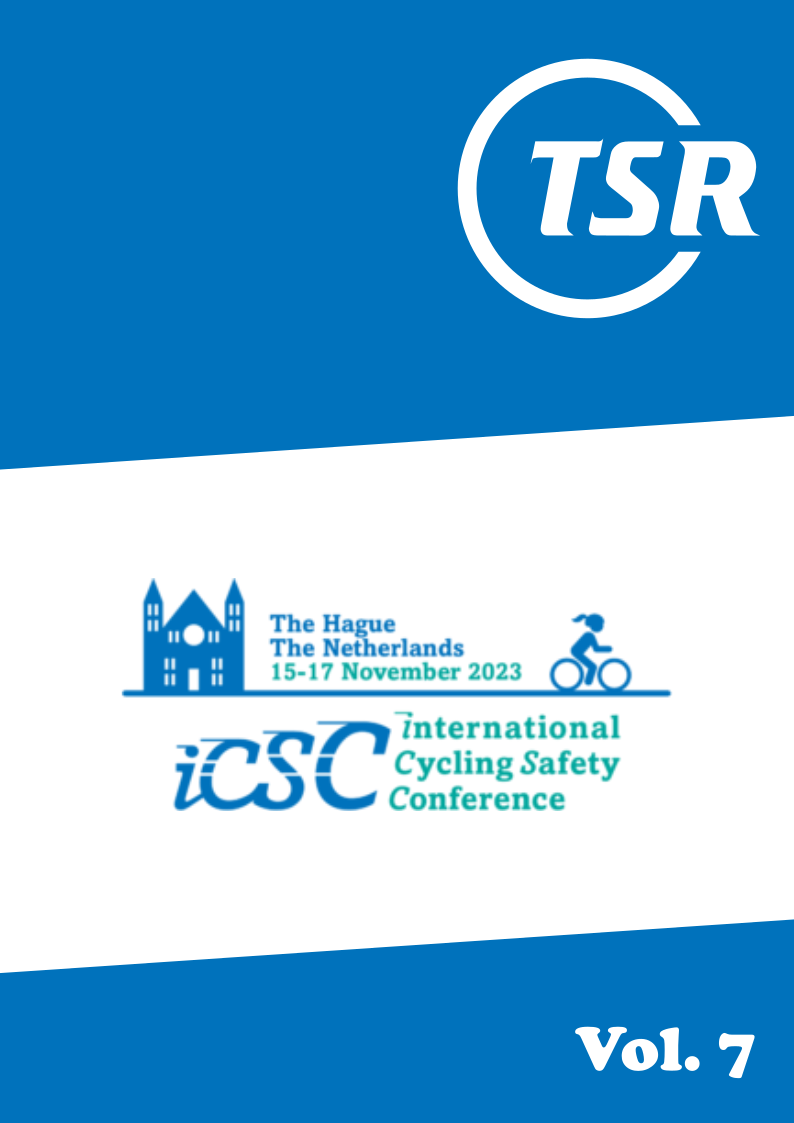What turns a bicycle street into a street for cyclists? A multimodal study on subjective safety of infrastructure measures on bicycle streets using an approach in virtual reality
DOI:
https://doi.org/10.55329/cmdy6439Abstract
In an increasingly urban and sustainable transportation-focused world, cycling emerges as a key environmentally friendly and health-promoting mode of travel. This paper addresses the gap in understanding cyclists' subjective safety, particularly in relation to bicycle streets in Germany. Utilizing a multimodal approach, two studies were conducted: an online questionnaire (Study I) and a Virtual Reality (VR) evaluation (Study II), focusing on the Reichenhainer Straße in Chemnitz. Study I involved N = 182 participants who regularly used the bicycle street. The questionnaire covered various aspects including mobility behavior, cycling experience, and subjective safety, using a 6-point Likert scale. Infrastructure characteristics were represented through images. Results showed that participants generally felt safe on the bicycle street, with key factors being the lane width and restrictions on motorized traffic. Study II, a pioneering effort in using VR and stereoscopic 360° images for evaluating cycling infrastructure safety, involved N = 32 participants. It provided a realistic evaluation of infrastructure elements and their impact on perceived safety. The study revealed significant differences in safety ratings based on the presence of cars and cyclists' experience levels. The use of VR allowed for a focused examination of infrastructure characteristics and their perceived safety, highlighting potential areas for improvement. Both studies demonstrated consistent results, underscoring the subjective safety of the Reichenhainer Straße, which was perceived as safer than the average bike-accessible infrastructure in Chemnitz. The VR method proved effective for detailed evaluation of subjective safety, independent of participants' familiarity with the specific infrastructure. This approach offers a structured, controlled, and resource-efficient way to evaluate cycling infrastructure under laboratory conditions. In conclusion, the findings align with existing literature and emphasize the importance of lane width and reduced motorized traffic for cyclists' safety. The innovative VR method, while still developing, offers promising implications for future citizen participation initiatives and infrastructure planning projects, enabling efficient post-completion evaluations of subjective safety. Such practices are rare in German planning offices, highlighting the paper's contribution to enhancing urban cycling infrastructure planning and safety assessment.
Downloads
References
ADFC, (2022), 'Fahrradklima-Test', Allgemeiner Deutscher Fahrrad-Club.
Alrutz, D. (2011), 'Die Empfehlungen für Radverkehrsanlagen (ERA)', FGSC Verlag.
Beck, B., M. Perkins, J. Olivier, D. Chong, M. Johnson (2021), 'Subjective experiences of bicyclists being passed by motor vehicles: The relationship to motor vehicle passing distance', Accident Analysis & Prevention, 155, 106102. DOI: https://doi.org/10.1016/j.aap.2021.106102
Blitz, A., A. Busch-Geertsema, M. Lanzendorf (2020), 'More cycling, less driving? Findings of a cycle street intervention study in the Rhine-Main Metropolitan Region, Germany', Sustainability, 12(3), 805. DOI: https://doi.org/10.3390/su12030805
BMDV, (2021), 'Ergebnisse einer repräsentativen Online-Befragung: Fahrrad-Monitor Deutschland [Bicycle Monitor Germany]', Bundesministerium für Verkehr und digitale Infrastruktur.
Franke, T., C. Attig, D. Wessel (2018), 'A personal resource for technology interaction: Development and validation of the affinity for technology interaction (ATI) scale', International Journal of Human-Computer Interaction, 35(6), 456–467. DOI: https://doi.org/10.1080/10447318.2018.1456150
Gössling, S., S. McRae (2022), 'Subjectively safe cycling infrastructure: New insights for urban designs', Journal of Transport Geography, 101, 103340. DOI: https://doi.org/10.1016/j.jtrangeo.2022.103340
Hull, A., C. O'holleran (2014), 'Bicycle infrastructure: can good design encourage cycling?', Urban, Planning and Transport Research, 2(1), 369–406. DOI: https://doi.org/10.1080/21650020.2014.955210
Lawson, A., V. Pakrashi, B. Ghosh, W. Szeto (2013), 'Perception of safety of cyclists in Dublin City', Accident Analysis & Prevention, 50, 499–511. DOI: https://doi.org/10.1016/j.aap.2012.05.029
Lusk, A., P. Furth, P. Morency, L. Miranda-Moreno, W. Willett, J. Dennerlein (2011), 'Risk of injury for bicycling on cycle tracks versus in the street', Injury Prevention, 17(2), 131–135. DOI: https://doi.org/10.1136/ip.2010.028696
Mahbubur, M., J. Kitson (2020), 'Using multi-sensory and multi-dimensional immersive virtual reality in participatory planning', Urban Science, 4(3), 34. DOI: https://doi.org/10.3390/urbansci4030034
Manton, R., H. Rau, F. Fahy, J. Sheahan, E. Clifford (2016), 'Using mental mapping to unpack perceived cycling risk.', Accident, Analysis & Prevention, 88, 138–187. DOI: https://doi.org/10.1016/j.aap.2015.12.017
Meuleners, L., M. Stevenson, M. Fraser, J. Oxley, G. Rose, M. Johnson (2019), 'Safer cycling and the urban road environment: A case control study', Accident Analysis & Prevention, 129, 342–349. DOI: https://doi.org/10.1016/j.aap.2019.05.032
Monsere, C., J. Dill, N. Mcneil, K. J. Clifton, N. Foster, T. Goddard, M. Berkow, J. Gilpin, K. Voros, D. van Hengel, J. Parks (2014), 'Lessons from the Green Lanes: Evaluating protected bicycle streets in the US', Portland State University.
Radwege Check, (2020), 'Studie zur subjektiven Sicherheit im Radverkehr Ergebnisse und Datensatz einer Umfrage mit über 22.000 Teilnehmenden', FixMyCity.
Sanders, R. (2013), 'Examining the cycle: How perceived and actual bicycling risk influence cycling frequency, roadway design preferences, and support for cycling among Bay Area residents', PhD thesis, University of California Transportation Center, Berkeley, USA.
Schwarzkopf, M., A. Dettmann, A. Heinz, M. Miethe, H. Hoffmann, A. C. Bullinger (2023), 'Let’s Use VR! A Focus Group Study on Challenges and Opportunities for Citizen Participation in Traffic Planning', International Conference on Human-Computer Interaction, Copenhagen, Denmark, 23–28 July 2023. DOI: https://doi.org/10.1007/978-3-031-35678-0_24
Schwarzkopf, M., A. Dettmann, J. Trezl, A. C. Bullinger (2022), 'Do you bike virtually safe? An explorative VR study assessing the safety of bicycle infrastructure', Human Factors and Ergonomics Society, Turin, Italy, 20–22 April 2022.
Schwedes, O., S. Wachholz, D. Friel (2021), 'Sicherheit ist Ansichtssache: Subjektive Sicherheit: ein vernachlässigtes Forschungsfeld', Technische Universität Berlin, Discussion paper.
Sinus Institut, (2021), 'Fahrrad-Monitor Deutschland', Sinus Institut für Markt- und Sozialforschung.
Sørensen, M., M. Mosslemi (2009), 'Subjective and objective safety—the effect of road safety measures on subjective safety among vulnerable road users', Institute of Transport Economics, TØI report 1009/2009.
Tsubohara, S. (2015), 'Streets for the coexistence of bicycles with cars', Journal of the City Planning Institute of Japan, 50(2), 221–232. DOI: https://doi.org/10.11361/journalcpij.50.221
Vandebona, U., M. Kiyota (2001), 'Safety perception issues related to pedestrians and cyclists', 24th Australasian Transport Research Forum (ATRF), Hobart, Australia, 17–20 April 2001.
Wang, J. Y., L. Mirza, A. K. Cheung, S. Moradi (2014), 'Understanding factors influencing choices of cyclists and potential cyclists: A case study at the University of Auckland', Road & Transport Research: A Journal of Australian and New Zealand research and practice, 23(4), 37–51. DOI: https://doi.org/10.3141/2432-05
Wolf, M., H. Söbke, F. Wehking (2020), 'Mixed Reality Media-Enabled Public Participation in Urban Planning', in Jung, T., M. C. t. Dieck, P. A. Rauschnabel (eds.), Augmented Reality and Virtual Reality, (Cham, Switzerland: Springer). DOI: https://doi.org/10.1007/978-3-030-37869-1_11
Zhang, Y., H. Liu, S. Kang, M. Al-Hussein (2020), 'Virtual reality applications for the built environment: Research trends and opportunities', Automation in Construction, 118, 103311. DOI: https://doi.org/10.1016/j.autcon.2020.103311
Published
How to Cite
Issue
Section
Categories
License
Copyright (c) 2024 Marc Schwarzkopf, André Dettmann, Angelika C. Bullinger

This work is licensed under a Creative Commons Attribution 4.0 International License.
Funding data
-
Bundesministerium für Bildung und Forschung
Grant numbers 01UR2204B










